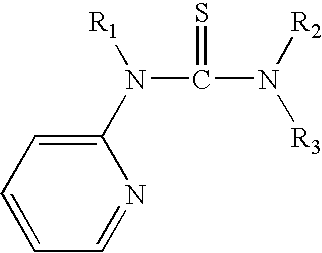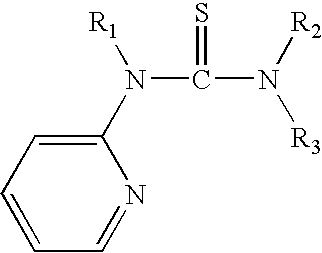Acid-tolerant dental composition
a technology of dental composition and acid-tolerant coating, which is applied in the field of dental compositions, can solve the problems of compromising the curing effect, the inability to use the photocure process, and the difficulty of light reaching the adhesive and cemen
- Summary
- Abstract
- Description
- Claims
- Application Information
AI Technical Summary
Benefits of technology
Problems solved by technology
Method used
Image
Examples
example 1
[0071]In making the pastes in this and the following examples, all the monomers and any ingredients soluble in the resin mixture were first mixed together to make a homogeneous liquid mixture, and then the fillers (TS-530, ST-OX-50, Sr / Zn FAS glass, or barium glass) were blended into the liquid mixture to make the paste.
[0072]An acid tolerant cement was made using the following composition.
[0073]
BaseBisGMA17.10GDM8.55HEMA5.13ETMPTA3.41CQ0.21MEHQ0.007ODMAB0.41PTU0.68TS-5303.00ST-OX-503.34Barium Glass58.16CatalystBisGMA9.70GDM9.70HEMA4.84GDM-P4.84ETMPTA3.24BHT0.05TMBHPO0.29CHPO0.58Water2.26TS-5303.00ST-OX-503.34Barium Glass58.16
[0074]When the base paste and catalyst paste were mixed at 1:4 ratio, the mixed material hardened (or set) after 4 minutes and 20 seconds. The self-cured (dark-cured) material had a flexural strength of 80.7 MPa, and a radiopacitiy that was 170% of aluminum.
example 2
[0075]An adhesion test to a dentin substrate was conducted on a commercial Panavia® F2.0 cementation system (Kuraray America, Inc., New York N.Y.). The Panavia® F2.0 cementation kit comprised two self-etching Primers (Primer A and Primer B) and a resin cement. Primer A and Primer B were packaged in two separate plastic bottles. The cement consisted of two pastes (base and catalyst pastes) packaged in two separate individual syringes.
[0076]The bonding strength was conducted as follows: The dentin surface was polished with wet 600 grit SiC paper. The primers were mixed at 1:1 ratio and the mixed primer was applied to dentin using a brush (separate acid etching was not necessary because the primers were self-etching). The pH of the mixed primers was 2.7 measured using pH paper. The primer was left on the dentin for 30 seconds and then the solvent was evaporated using compressed air for 2-3 seconds. A plastic mold with an inner diameter of 2.38 mm was securely placed over the primed too...
example 3
[0078]An adhesion test to a dentin substrate was conducted on another commercial cementation system, Multilink® (Ivoclar Vivadent Inc., Amherst, N.Y.). The Multilink® cementation kit comprised two self-etching Primers (Primer A and Primer B) and a resin cement. Primer A and Primer B were packaged in two separate plastic bottles. The cement consisted of two pastes (base and catalyst pastes) packaged in separate barrels of a dual-barrel assembly. The bonding strength was conducted in the same manner as described in Example 2. The primers were mixed at 1:1 ratio and the mixed primer was applied to dentin using a brush (the pH of the mixed primers was 2.5 measured using pH paper). The primer was left on dentin for 15 seconds and then the solvent was evaporated using compressed air for 2-3 seconds. A plastic mold with an inner diameter of 2.38 mm was securely placed over the primed tooth surface. The cement was dispensed from the dual-barrel assembly and homogeneously mixed. The mixed ce...
PUM
| Property | Measurement | Unit |
|---|---|---|
| mean particle size | aaaaa | aaaaa |
| mean particle size | aaaaa | aaaaa |
| mean particle size | aaaaa | aaaaa |
Abstract
Description
Claims
Application Information
 Login to View More
Login to View More - R&D
- Intellectual Property
- Life Sciences
- Materials
- Tech Scout
- Unparalleled Data Quality
- Higher Quality Content
- 60% Fewer Hallucinations
Browse by: Latest US Patents, China's latest patents, Technical Efficacy Thesaurus, Application Domain, Technology Topic, Popular Technical Reports.
© 2025 PatSnap. All rights reserved.Legal|Privacy policy|Modern Slavery Act Transparency Statement|Sitemap|About US| Contact US: help@patsnap.com



